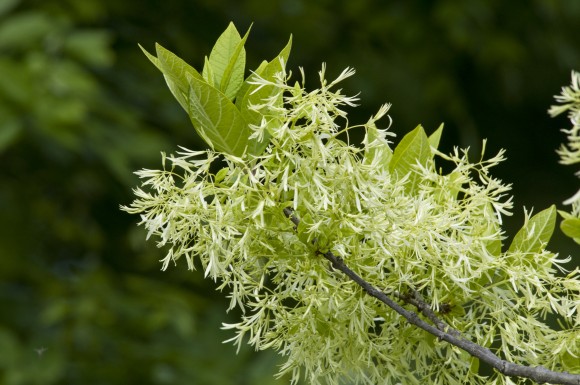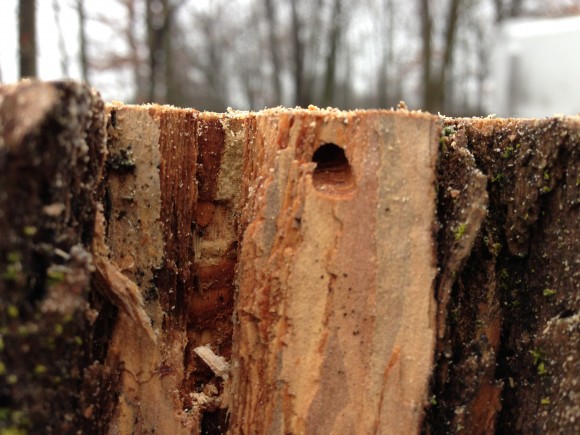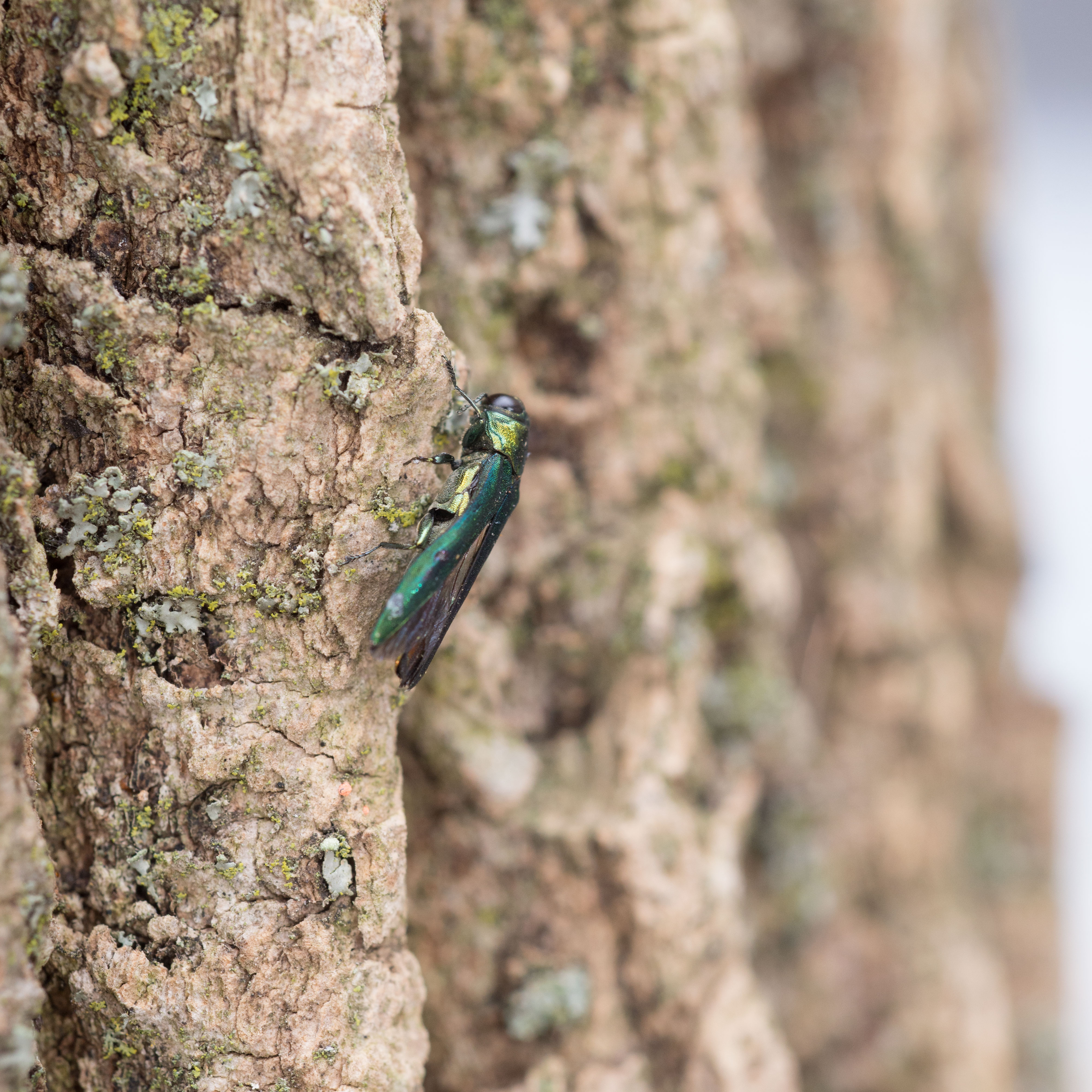Last week, a college biology professor in Ohio announced he had found evidence that the emerald ash borer (EAB), an invasive insect decimating the continent’s ash trees, is also attacking white fringetrees (Chionanthus virginicus).

In August he found the telltale D-shaped exit holes on a fringetree near his home. When he investigated further by peeling back the bark, he found feeding galleries and live borers. He had the borers positively identified morphologically as well as with DNA tests conducted by the USDA’s Animal and Plant Health Inspection Service (APHIS). He also found evidence of EAB activity on fringetrees in three other locations in Ohio.
The recent discovery marks the first time EAB has been found completing its life cycle on anything other than ash in the United States.
The finding adds an alarming new element to the EAB story:
- Researchers have been wondering whether the host range for EAB could be wider than just ash. That theory had seemed unlikely up to now but is proven with the fringetree discovery. There has already been a lot of research investigating other possible hosts, and with the new discovery, there will likely to be more.
- Is the insect adapting? This is a scary thought!
- Will EAB kill fringetrees as it does ash, or just cause damage? So far the invasive insect appears to only be damaging—not killing—fringetrees.
- Has EAB moved to fringetrees because EAB populations are locally so high? If the buffet is crowded at the “prime rib station,” it seems logical that “meatloaf station” may get some visits.
- What will happen when ash tree populations dwindle? Will the EAB population die back, or just move to a secondary host (the meatloaf, as the prime rib is gone) and/or develop a completely new palate?

The Ohio professor’s find was not all by luck; he had reason to focus on the white fringetree. Laboratory studies have shown that the adult EAB will feed on the foliage of other tree species in the same family as ash—the olive family, or Oleaceae. Members include ash (Fraxinus), fringe tree (Chionanthus), lilac (Syringa), forsythia, privet (Ligustrum) and swamp privet (Forestiera). Literature from Asia, the homeland of the EAB, indicates other secondary EAB hosts.
The Chicago Botanic Garden has 42 fringetrees; all have been inspected and show no signs of EAB activity. Even a fringetree that is 25 feet from an ash tree that was heavily infested with EAB shows no signs. If you have a fringetree, you should inspect it for signs of EAB. These include dieback starting at the upper limbs of the tree, new growth on the lower trunk, and small, D-shaped holes where the larvae have exited through the bark. Emerald ash borer larvae can kill a mature ash tree in two to three years by destroying the tree’s vascular system.
Find more information on identifying and dealing with EAB on our website, and in our previous posts, Signs of Emerald Ash Borer, and Emerald Ash Borer: Sad But True, Part 2.
As the world has become less fragmented by ease of transportation, more exotic, high-consequence plant pests and pathogens like EAB have entered—and will continue to enter—the country. Other exotic plant pests and pathogens we are watching for at the Garden include the following: viburnum leaf beetle, Lymantria dispar asiatica moth, brown marmorated stink bug, Asian longhorned beetle, thousand cankers disease, plum pox virus, chrysanthemum white rust, sudden oak death, and so on; most are already in the country. Vigilance and education are the key to managing and slowing the spread of these foreign invaders.
The Garden is a member of the Sentinel Plant Network, a group that unites botanic gardens in monitoring and providing education on exotic plant pests and pathogens, and works in partnership with the National Plant Diagnostic Network (NPDN).
If you are a plant and bug person like me, please consider becoming a NPDN First Detector and help be on the lookout for these exotic plant pests and pathogens. The NPDN offers an online training course to become a First Detector at firstdetector.org. It’s free, and upon completion, you even get a printable certificate!
©2014 Chicago Botanic Garden and my.chicagobotanic.org


In the 1980s and 90s they were able to curtail the damage done by armies of gypsy moth caterpillars by killing them with aerial spraying. Why can’t they use an insecticide specific to the emerald ash borer? Even if they have to do repeat spraying said. This insect has decimated the northern forest of are beautiful ash trees. Forest stand bare. It’s horrific.
Thanks for your comment, Sharon. Managing gypsy moth is much different than managing emerald ash borer (EAB)—apples and oranges in more ways than one!
Unfortunately there are no insecticides specific only to EAB. To manage EAB with this aerial spray approach, a spray of a non-selective insecticide would need to take place about every 14 days mid-May through August, as adult emergence is not synchronized. This type of application would have major non-target impact affecting all insects, including the beneficial ones; not to mention the effects on mammals, including humans. There are systemic insecticides (closed system, as they are injected into the trunk, not sprayed) being used to protect individual ash trees from EAB, but this is a tree by tree approach is not practical for large forested areas.
The primary product used in aerial spray treatments in forested areas for gypsy moth management has been Bacillus thuringiensis (Bt). Bt is a natural bacteria that is specific to Lepidoptera/caterpillars, but must be ingested by the caterpillar. Bt is considered a very safe product, safe around mammals, is considered organic, and has minimal impact on the environment. The gypsy moth has a very synchronized life cycle (all overwintering eggs hatch about the same time) and one well-timed (14 days after egg hatch) spray of Bt when the young caterpillars are out works very well, as you commented. Also, keep in mind that gypsy moth only damages foliage, and healthy trees can recover from gypsy moth damage. Trees can tolerate a low level of infestation just fine; often just by lowering the overall gypsy moth population does the trick. There are natural predators and pathogens that strike a balance with gypsy moth; naturally bringing damage to a low tree tolerable level.
One last thought on killing vs. damaging: EAB directly kills a tree quickly by cutting off the upward flow of nutrients and water; whereas gypsy moth causes foliar damage that generally just puts a tree into a stress decline, unless it happen severely for multiple years in a row.
I WISH we had a silver bullet for this currently unstoppable menace!
Tom
We are members of the Botanic Garden and live a few miles away. We have about a dozen Ash Trees in our back yard. I’ve taken a couple down already. Can I leave the remaining ones standing until serious damage appears or would it be better to take them all down. Also should they be taken down to the ground or can the trunks be left standing?
Stuart, it is best to take them down proactively before they are seriously damaged. Dead ash branches and limbs become brittle and hazardous very quickly. Also, tree care companies will charge more for the removal of dead or mostly dead trees because the removals are a lot more difficult and dangerous. It’s best to take them down to the ground, or you’ll just have a big, dead tree trunk—if tall enough, it could become a hazard. If you wanted to leave it a few feet up to put a planter on, that would be fine. Also, if the ash trees are not already infested, you may want to consider systemic insecticide treatments; they are highly effective if begun before the tree is damaged.
I live in northern Lake County and something killed my crab tree – along with many neighbor’s crab trees – in mid-summer. Any thoughts on this?
Unfortunately, Leba, this isn’t a question I can answer without more information, but I can tell you that crabapples have not been found to be affected by emerald ash borer. Our plant information service may be able to help you with your specific issue. You can contact them online at http://www.facebook.com/plantinfo.chicagobotanicgarden, or for a more immediate response, upload photos and other information about your crabapple to their online form at http://www.chicagobotanic.org/plantinfoservice.
We encourage all campers to leave their firewood at home, buy and burn it locally to prevent EAB from spreading father. However we see it all the time that campers are bringing in their own firewood, even hiding their firewood form us. You don’t have to hide it from us, it is not because of us, believe me I personally don’t care where you get your firewood from, BUT it would be for the greater goods of stopping the disease. Until we change our behavior this disease will hurt us over and over again! And the next disease is on the rise, even worse with the Asian beetle!
Yes, Patricia, the number one way emerald ash borer jumps to new locations is by the movement of ash wood, often firewood. There are state and federal quarantines in many states, but enforcement is difficult. The true key is education. If people have a clear understanding of why they should not move firewood, they might think twice before transporting it. There are free brochures available on this exact topic that you may want to seek out and distribute to your campers. Good luck; it’s an uphill battle.
I live in a neighborhood built during the housing boom of which many parkway trees where ash. By the neightborhoods 3rd year most trees where on the way out due to the EAB. I have had to take down a young Red Summerset Maple due to the EAB as well.
R, sorry to hear your neighborhood was so heavily planted with ash. Hopefully the replacement trees will have good diversity. I also wanted to let you know that EAB does not attack maple; unfortunately, there must have been some other problem with your maple, or you were misled.